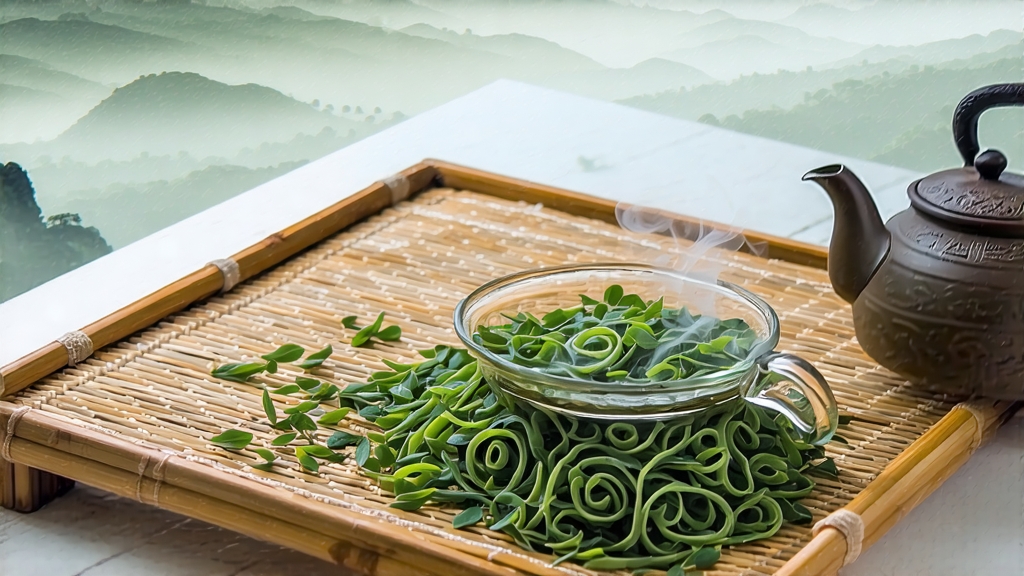
Tucked between the mist-laden slopes of Dongting Mountain in Jiangsu Province and the vast, fish-teeming expanse of Lake Tai, Biluochun—literally “Green Snail Spring”—has captivated Chinese emperors, poets, and tea traders for more than a thousand years. To the uninitiated, the name may sound whimsical; to the seasoned tea traveler, it evokes the promise of tiny jade spirals that unfurl in hot water to release an aroma surprisingly reminiscent of apricot blossom and lake breeze. This essay invites the international reader on a sensory journey through Biluochun’s history, micro-terroirs, meticulous crafting, and the quiet ritual that turns leaf and water into liquid springtime.
-
Historical echoes
The first reliably dated mention appears in the Tang Dynasty (618-907) classic “The Classic of Tea,” yet legend pushes the story back to the Eastern Jin (317-420). A monk, so the tale goes, found a tea shrub thriving under the shade of wild plum, peach, and apricot trees. Noticing the leaves exuded a natural fruity fragrance, he harvested and pan-fired them, naming the brew “Xia Sha Ren Xiang”—“Scary-fragrant” because its aroma was almost too intense for the cloister’s tranquility. During the Kangxi reign (1662-1722) of the Qing, the emperor—touring the Lake Tai region—sampled the tea, found the name inelegant, and rechristened it Biluochun for its snail-shell shape and spring harvest. Court annals record that the imperial caravan carried thirty-six small tin caddies back to Beijing, instantly elevating the tea to tribute status and fixing its reputation among the “Ten Famous Chinese Teas.” -
Terroir: where mountain meets water
Dongting Mountain is actually two islands—East and West—anchored in Lake Tai like a pair of jade seals. The lake’s microclimate moderates temperature, while constant humidity shrouds the terraces in fog that filters sunlight into soft, diffused rays. This natural shade raises chlorophyll and amino-acid levels, especially L-theanine, which bolsters sweetness and umami. Soils are acidic, a sandy loam strewn with weathered granite that drains quickly yet retains enough moisture to stress the shrubs gently, concentrating aromatic compounds. Within the appellation, one finds minute differences: east-facing slopes receive morning sun and yield teas with higher floral notes; west-facing plots capture afternoon heat, developing deeper, nuttier profiles. The most coveted sub-section is known as “Rock Core,” where roots penetrate crevices and absorb trace minerals that lend a subtle flinty finish. -
Cultivars and picking standards
Although the classic genotype is the Dongting小叶群体种 (small-leaf heirloom population), clonal selections such as Fuding Dabaicha and Wuniuzao have been introduced to extend the harvest window. Purists, however, insist that only the island’s own shrubs deliver the signature “marine” hint. Picking begins when two-thirds of the buds show a pale jade hue—usually two weeks around Grain Rain (late April). The golden rule is “one bud with one just-unfolded leaf,” no longer than 2.5 cm, weighing 0.3 g apiece. Experienced pluckers finish 500 g of fresh leaf in four hours; it will shrink to 100 g finished tea, enough for perhaps twenty small cups. -
The six-hour metamorphosis
Biluochun remains one of the last Chinese green teas still entirely hand-crafted in small batches. The process unfolds in six contiguous steps:
a. Withering: Fresh leaves are spread on bamboo sieves set under shade cloth for two hours, reducing moisture by roughly 10 % and softening cell walls.
b. Primary firing (杀青): A wok heated to 180 °C receives 250 g of leaf. The maker’s bare hands flutter through the mass in a motion called “trembling kill-green,” lasting four minutes. Temperature is judged by ear: the moment leaf crackle subsides, the fire is damped.
c. Rolling (揉捻): While still warm, the tea is rolled on a rattan mat into tight strips; pressure increases gradually to rupture epidermal cells without breaking the bud tip.
d. First shaping: The critical “spiral twist” occurs at 70 °C. The artisan cups a handful of leaves, presses them against the wok’s rim, and